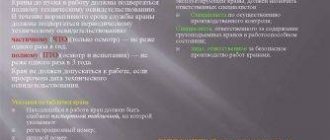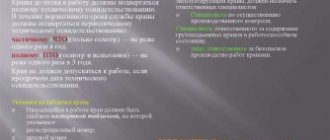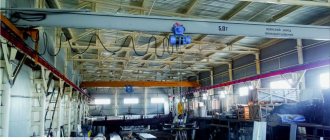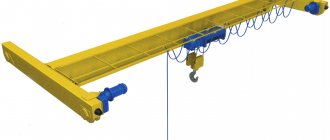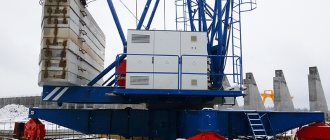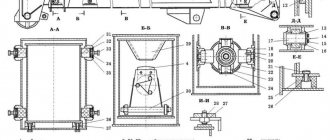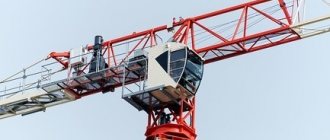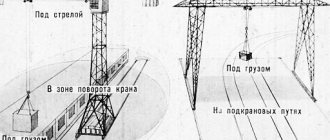Technical examination of cranes
Technical inspection of cranes can be partial or complete.
During the standard service life, periodic technical inspection of cranes is carried out in the following periods:
a) partial - at least once every 12 months;
b) complete - at least once every 3 years, with the exception of rarely used cranes (cranes for servicing machine rooms, electrical and pumping stations, compressor units, as well as other cranes used only for equipment repairs).
A full technical inspection of cranes that are classified as rarely used is carried out at least once every 5 years. The classification of cranes into the category of rarely used is carried out by the owner in agreement with the Rostekhnadzor authorities.
Technical inspection of cranes aims to establish that:
a) the crane and its installation comply with PB Rules No. 533, passport data and submitted documentation;
b) the crane is in a condition that ensures its safe operation.
Comprehensive examination
A comprehensive inspection of the track is mandatory in accordance with the requirements of industrial safety rules; work on a comprehensive inspection is carried out by specialized expert organizations that have the appropriate license to perform work of this type.
The frequency of a comprehensive examination is at least once every 3 years. In the intervals between inspection work, at least once a year, the owner of the lifting structure must ensure that the crane tracks are leveled to control the horizontal position and ensure safe operating conditions. In the absence of proper fastening of the guides, or the presence of deviations exceeding permissible standards, there is a possibility of an emergency situation, a threat to the life and health of operating personnel. In the event of an emergency equipment failure, unexpected equipment downtime occurs, which inevitably entails economic losses in production.
During the comprehensive survey work, they are checked.
- Availability of an organized service for operating the lifting structure
- Technical and operational documentation
- Planned-altitude survey and inspection of crane track elements is carried out
- Guides (rail, square, I-beam)
- Butt and intermediate fastenings
- Dead-end stops, limiters, guards, warning signs, grounding
- Metal structures and their fastening units
A set of documentation based on the results of a comprehensive survey:
Based on the results of technical inspection work, the following documentation is provided:
- Certificate of comprehensive inspection of the crane runway
- List of defects based on the results of the inspection (if any)
- Plan-height survey of crane track elements
Scope of work during technical inspection of cranes
When carrying out a technical inspection of cranes, it is necessary to inspect and check the operation of its mechanisms, brakes, hydraulic and electrical equipment, instruments and safety devices. Checking the serviceability of the load limiter of a jib-type crane should be carried out taking into account its load characteristics.
In addition, during the technical inspection of the crane the following must be checked:
a) the condition of the metal structures of the crane and its welded (riveted) connections (no cracks, deformations, thinning of walls due to corrosion, weakening of riveted connections, etc.), as well as the cabin, stairs, platforms and fences;
b) the condition of the hook and blocks. For cranes transporting molten metal and liquid slag, for ladle lifting and tilting mechanisms, inspection of forged and stamped hooks and parts of their suspension, as well as suspension parts of plate hooks, must be carried out by the factory laboratory according to instructions using non-destructive testing methods at least once every 12 months . The laboratory report must be stored together with the crane passport.
c) the actual distance between the hook suspension and the stop when the limit switch is activated and the lifting mechanism stops (must be at least 200 mm for cranes);
d) the state of insulation of wires and grounding of the electric tap with determination of their resistance;
e) compliance of the mass of the counterweight and ballast of the jib crane with the values specified in the passport;
f) the condition of the rail track, its compliance with the substation operating manual, the project, as well as the requirements of these FNP;
g) the condition of the ropes and their fastenings;
h) state of lighting and alarm.
Static tests of the crane are carried out with a load 25% greater than its rated load capacity.
Static tests of an overhead crane are carried out as follows. The crane is installed above the supports of the crane track, and its trolley (trolleys) is installed in a position corresponding to the greatest deflection of the bridge. The test load is lifted by crane to a height of 100 - 200 mm and maintained in this position for 10 minutes.
After 10 min. the load is lowered, after which the absence of residual deformation of the crane bridge is checked. If there is residual deformation resulting from testing the crane with a load, the crane should not be allowed to operate until a specialized organization has clarified the causes of the deformation and determined the possibility of further operation of the crane. Static testing of gantry crane and overhead material handler is carried out in the same way as overhead crane testing; in this case, for a crane with consoles, each console is tested separately.
Static tests of a jib-type crane having one or more load characteristics are carried out in a position corresponding to the crane's maximum load capacity. During static tests of jib-type cranes, the boom is installed relative to the running support in a position that corresponds to the lowest design stability of the crane, and the load is raised to a height of 100 - 200 mm. The crane is considered to have passed static tests if within 10 minutes. the lifted load will not fall to the ground, and cracks, residual deformations and other damage to metal structures and mechanisms will not be detected.
Dynamic tests of the crane are carried out with a load whose mass is 10% greater than its rated load capacity, and are aimed at checking the operation of its mechanisms and brakes.
During dynamic testing of cranes (except for cable-type cranes), the load is lifted and lowered multiple times (at least three times), as well as the operation of all other mechanisms is checked when combining working movements provided for in the crane operating manual. For a crane equipped with two or more lifting mechanisms, each mechanism must be tested.
To conduct static and dynamic tests, the crane owner must ensure the availability of a set of test (control) weights indicating their actual weight. Technical examination of cranes (cranes) must be carried out by a specialist responsible for carrying out production control during the operation of the substation with the participation of a specialist responsible for the safe performance of work using lifting structures intended for moving goods.
Rostekhnadzor explains: Technical inspection of lifting structures (CHTO, PTO at substations)
Letter of Rostechnadzor dated February 12, 2020 N 09-00-06/1075 “On the operation of the substation”
FEDERAL SERVICE FOR ECOLOGICAL, TECHNOLOGICAL AND NUCLEAR SUPERVISION LETTER
dated February 12, 2022 N 09-00-06/1075
ABOUT THE OPERATION OF THE PS
In connection with the appeal, the Department of State Construction Supervision of the Federal Service for Environmental, Technological and Nuclear Supervision reports.
Clause 168 of the Federal norms and rules in the field of industrial safety “Safety rules for hazardous production facilities where lifting structures are used”, approved by Rostekhnadzor Order No. 533 dated November 12, 2013, establishes that the substations listed in paragraph 3 of these FNPs must be subject to technical inspection before their commissioning, as well as during operation. The scope of work, the procedure and frequency of technical examinations are determined by the manual (instructions) for the operation of the substation. If the manual (instructions) for the operation of the substation does not contain instructions for conducting a technical examination, the technical examination of the substation is carried out in accordance with these FNP.
Head of the Department of State Construction Supervision A.N.GORLOV
Question from 05/17/2018:
Clause 173 of the FNP on PS states that during a full technical examination of lifting structures (PS), static and dynamic tests are carried out. When conducting an industrial safety examination of a substation, the Program for carrying out the examination work agreed upon by the expert organization and the customer organization includes, among other things, static and dynamic tests. Clause 193 of the FNP for PS states that technical examination of a PS is permitted to be carried out by expert organizations.
Please clarify, if a full technical examination is carried out by the person responsible for the implementation of production control after the examination (in the conclusion of the examination there is no record of the technical inspection carried out, therefore we believe that the technical inspection was not carried out), is it possible not to carry out static and dynamic tests, but to use the relevant test reports from industrial safety examination reports signed by experts.
Answer: Protocols of relevant tests from the conclusion of the industrial safety examination, signed by experts. They are part of the industrial safety examination documentation. But a full technical examination was not carried out (it is carried out during the examination of the safety documentation only in accordance with clause 263).
In accordance with paragraph 171. Technical examination of the substation must be carried out by a specialist responsible for carrying out production control during the operation of the substation, as well as with the participation of a specialist responsible for maintaining the substation in working condition.
Thus, you need to conduct a full technical examination and make an entry in the PS passport.
Question:
If a partial or complete technical examination of cranes and hoists (hereinafter – PS) was carried out by a specialized organization, who makes an entry in the PS passport: a specialist responsible for production control at the enterprise, or a specialist from a specialized organization?
Answer: This question was answered by specialists from the Department of State Construction Supervision of Rostechnadzor.
According to paragraph 193 of the Federal norms and rules in the field of industrial safety “Safety rules for hazardous production facilities where lifting structures are used”, approved by Order of Rostechnadzor dated November 12, 2013 No. 533, regardless of the fact that the technical examination of the substation was carried out with the involvement of an expert organization, including during the examination of the industrial safety of the substation, the results of the technical examination are recorded in the passport of the substation by the specialist responsible for carrying out production control during the operation of the substation.
Question:
Please clarify whether, after conducting an industrial safety examination and recording in the lifting structure (PS) passport, in accordance with clause 6.14.7 of the Recommendations for the expert examination of lifting machines. General provisions (RD 10-112-1—04), make an additional entry about carrying out a technical examination in the PS passport, although, according to clause 6.10.5 RD 10-112-1-04, the results of cargo tests are documented in an act that is part of the conclusion of the industrial safety examination of a technical device at a hazardous production facility? V.F. Ezhak, ch. engineer at JSC Novosibirsk Switch Plant
The head of the State Construction Supervision Department of Rostechnadzor, A.N., answers readers’ questions. Gorlov.
Recommendations for expert examination of lifting machines. The general provisions (RD 10-112-1-04) have not undergone appropriate state registration, do not entail legal consequences and cannot serve as a basis for regulating relevant legal relations or applying sanctions to citizens, officials and organizations for failure to comply with the norms contained therein. RD 10-112-1-04 cannot be referred to when resolving disputes.
RD 10-112-1-04 can be used when conducting inspections of lifting machines as a recommendation document.
Cases of making appropriate entries in the passports of lifting machines during their operation, including based on the results of technical examinations, are determined by the requirements of the Federal norms and rules in the field of industrial safety in force since March 7, 2014 on the territory of the Russian Federation “Safety rules for hazardous production facilities where lifting structures”, approved by Rostechnadzor order No. 533 dated November 12, 2013, registered by the Ministry of Justice of Russia on December 31, 2013, registration No. 30992.
PRELIMINARY ONLINE APPLICATION
Testing of lifting mechanisms, technical devices for lifting loads, lifting structures, structures, cranes, hoists.
Lifting structure - definition of the term. A lifting structure is a single system that combines building structures and structures, with designated boundaries determined by production processes and characteristics that include a lifting machine or mechanism.
The main control measures carried out during the operation of the lifting structure are determined by the requirements of the Federal norms and regulations in the field of industrial safety “Safety rules for hazardous production facilities where lifting structures are used”, introduced by Order of Rostechnadzor dated November 12, 2013 N 533 (FNP PS) . These include:
- technical examination (TO);
- industrial safety examination (ISA).
TYPICAL TECHNICAL SPECIFICATIONS FOR TECHNICAL INSPECTION OF LIFTING STRUCTURES AND MECHANISMS Khimnefteapparatura LLC carries out technical inspection of lifting structures in the shortest possible time at an objective price based on the technical specifications. received from the customer. You can download a technical specification document template and send it to our email address to clarify the details, timing and cost of work with our specialists.
File name: Terms of reference for inspection of lifting structures
121080 287228.13KB
Technical examination of lifting structures
For which lifting structures is technical inspection carried out?
For all lifting structures specified in clause 3 of the FNP PS (both those registered with Rostechnadzor and those not subject to registration with Rostechnadzor) it is necessary to carry out a technical examination.
a load-lifting cranes of all types;
b overhead stacker cranes;
in pipe-laying cranes;
g cranes;
d construction lifts;
e lifts (towers) designed to move people, people and cargo (lifts with working platforms);
g electric freight trolleys moving along elevated rail tracks together with a control cabin;
h electric hoists;
and excavator cranes designed to work with a hook;
to replaceable load-handling devices and removable load-handling devices (hooks, grabs, magnets, spreaders, traverses, grippers, slings), used in conjunction with the PS for lifting and moving loads;
l containers for transporting goods, with the exception of special containers used in metallurgical production (ladles, molds), as well as special containers used in sea and river ports;
m special removable cabins and cradles, hung on the load-handling parts of cranes and used for lifting and moving people;
n rail tracks (for supporting and suspended substations moving on rails).
Scope of work, procedure and frequency of technical examination:
Lifting structures must undergo technical inspection before they are put into operation, as well as during operation. The scope of work, the procedure and frequency of technical examinations are determined by the manual (instructions) for the operation of the substation. A similar amount of work is performed during extraordinary technical examinations in cases established by the Federal Tax Service.
FREQUENCY OF TECHNICAL INSPECTION DURING THE SERVICE LIFE OF THE LIFTING STRUCTURE:
- partial technical examination (PTO) - at least once every 12 months;
- full technical examination (PTO) - at least once every 3 years, with the exception of rarely used substations .
SCOPE OF WORK DURING TECHNICAL INSPECTION OF LIFTING DEVICES, MECHANISMS, CRANES AND STRUCTURES:
- partial technical examination (PTO) – inspection only;
- full technical examination (PTO) – inspection, static tests of lifting mechanisms, dynamic tests of lifting mechanisms.
The static test is carried out by loading the lifting structure at 25% greater than the rated load capacity.
Dynamic testing of a lifting structure is carried out with a load 10% greater than the rated load capacity.
The purpose of the static test is to check the strength of metal structures and mechanisms of the substation. During dynamic testing, the operation of mechanisms and brakes is checked.
Who carries out the technical inspection?
A specialist responsible for carrying out production control during the operation of the substation, as well as with the participation of a specialist responsible for maintaining the substation in working condition. At the same time, technical inspection of lifting structures is permitted to be carried out by expert organizations.
The technical inspection of lifting structures is carried out by experts from Khimnefteapparatura LLC, certified in the manner established by the Decree of the Government of the Russian Federation of May 28, 2015. No. 509 “On the certification of experts in the field of industrial safety.”
What is done during a technical inspection?
During a technical inspection, the lifting structure must be inspected and its mechanisms, brakes, hydraulic and electrical equipment, indicators, limiters and recorders checked.
During the technical inspection of the crane, the condition of the metal structures of the crane and its welded (riveted, bolted) connections must be checked (no cracks, deformations, loosening of riveted and bolted connections), as well as the condition of the cabin, stairs, platforms and fences, the condition of the hook and blocks.
During the technical inspection of lifts the following must be checked:
- the condition of the metal structures of the lift and its welded (bolted) connections (no cracks, deformations, loosening of bolted connections), as well as the condition of the cabin, stairs, platforms and fences;
- compliance with the drawing and lift passport data with the actual installed weight of the counterweight and ballast (if any);
- condition of fastening of axles and pins; condition of hydraulic equipment (if any);
- electrical grounding condition; operability of catchers with testing (for construction hoists);
- checking the accuracy of stopping the car with full working load and without load (for construction hoists).
How to make a duplicate passport for a lifting structure?
According to clause 144 of the FNP PS, a duplicate of the passport and a duplicate of the operating manual (instructions) must be produced by the manufacturer of the lifting structure. Or by a specialized organization licensed to conduct an industrial safety examination, while the expert organization prepares a duplicate passport based on the industrial safety examination carried out before the start of operation of the substation at the hazardous production facility.
If during operation the passport and/or operating manual for the lifting structure are lost, then to restore them it is necessary to carry out technical diagnostics.
At the end of the service life of lifting structures subject to registration in Rostekhnadzor, it is necessary to conduct an industrial safety examination to assess the terms and conditions for further safe operation of the substation.
At the end of the service life of lifting structures that are not subject to registration by Rostechnadzor, it is necessary to carry out technical diagnostics.
Industrial safety examination
An industrial safety examination is mandatory for carrying out a set of works during the operation of a hazardous production facility. When conducting an examination, it is necessary to be guided by Federal Law No. 116 “On Industrial Safety of Hazardous Production Facilities.”
The examination includes a set of measures to check the condition of technical documentation, organize a service for the safe operation of a hazardous production facility, and assess the technical condition of equipment. Based on the results of the examination, a conclusion is issued containing an expert assessment of the condition of the lifting mechanism and design documentation.
When is an industrial safety review carried out?
- Expiration of the service life of the PMG on a periodic basis
- Lack of design documentation
- After reconstruction, modernization
- After an emergency occurs
- Change of owner of a lifting structure
- As prescribed by Rostekhnadzor
Industrial safety examinations are carried out by expert organizations licensed by Rostechnadzor. The expert’s conclusion makes one of the following orders:
- Permission for further operation of the crane
- Restricted admission
- Repair order
- Prohibition of further exploitation
Maintenance of crane-manipulator installations
Shift service
During shift maintenance, the technical condition of the crane and its readiness for work are checked. Shift maintenance includes cleaning and washing, inspection and refueling work.
During control work, a visual inspection and verification is carried out:
- condition and fastening of all components of the crane;
- hydraulic system tightness;
- operation of the load limiting system;
- hydraulic fluid level in the tank;
- condition of lifting devices.
Washing work is carried out once per shift, after finishing work. To avoid oxidation of chrome parts, use only pH-neutral detergents, and make sure they are biodegradable. If you are using a pressure washer, the temperature of the cleaning agent should not exceed 60°C.
Maintenance #1
Maintenance No. 1 (TO-1) is carried out no later than after 50 operating hours of the installation, or no later than 2 (two) months (the list of necessary work may vary depending on the brand, model of the installation and the requirements of the manufacturer) and includes :
- carry out the entire list of works prescribed by the regulations for daily maintenance
- checking the condition and fastening of all installation components;
- checking the tightness of the hydraulic system;
- checking the operation of the load limiting system (security system);
- checking the fluid level in the hydraulic tank and gearboxes;
- checking the condition of lifting mechanisms and cables;
- lubricate the installation elements;
- check the tightness of all threaded connections and mounting studs of the installation;
- replace oil filters;
Maintenance #2
Maintenance No. 2 (TO-2) is carried out no later than after 500 operating hours of the installation, or no later than 6 (six) months (the list of necessary work may vary depending on the brand, model of the installation and the requirements of the manufacturer) and includes :
- carry out the entire list of work prescribed by the regulations for shift maintenance and also for maintenance-1;
- check the condition of the welds (column, slewing bearing, boom equipment and outriggers);
- determine the performance of hydraulic cylinders and hydraulic locks.
Maintenance #3
Maintenance No. 3 (TO-3) is carried out no later than after 1000 operating hours of the unit, or no later than 12 (twelve) months (the list of required work may vary depending on the brand, model of the unit and the requirements of the manufacturer) and includes :
- carry out the entire list of work prescribed by the regulations for shift maintenance, as well as for TO-1 and TO-2;
- change the oil in the hydraulic system (some manufacturers require changing the oil in the hydraulic system at earlier maintenance). The oil should be changed at least once a year.
